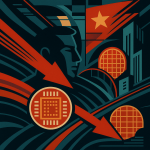Key Points
- China is launching new policy financial instruments starting with an initial fund size of around ¥500 billion RMB ($69.72 billion USD) to boost its economy, primarily through infrastructure investment.
- Key policy banks like China Development Bank are leading the initiative, building on their experience from deploying ¥740 billion RMB ($103.28 billion USD) in similar funds in 2022.
- Funds are strategically allocated not just for traditional infrastructure but also for future-forward sectors including the Digital Economy, Artificial Intelligence (AI), and the Low-Altitude Economy.
- The People’s Bank of China (PBOC) supports this by providing low-cost, long-term loans through its Pledged Supplementary Lending (PSL) facility, with the interest rate recently cut to 2%.
- The initial ¥500 billion RMB is expected to have a significant “leverage” effect, potentially attracting an incredible ¥1.5 trillion to ¥2.5 trillion RMB ($209.18 billion USD to $348.63 USD) in total infrastructure investment, forecasting a 6.0% rebound in full-year infrastructure investment growth.

China is gearing up to launch a new wave of policy financial instruments, and if you’re an investor, founder, or just watching the global tech scene, this is something you need to pay attention to.
Recent signals from the National Development and Reform Commission and local governments are all pointing in the same direction: a major economic push is on the horizon.
Let’s break down what’s happening and what it means.
The Lowdown: What Are These New Financial Tools?
Think of these as a strategic injection of capital designed to fire up the economy, specifically targeting infrastructure.
And local governments from Guangzhou (Guangzhou 广州) to Yibin (Yibin 宜宾) are already scrambling to get their projects lined up.
Here’s a snapshot of the plan.
How Big is the War Chest?
The initial scale is massive.
Discussions in Yibin point to a starting fund size of around ¥500 billion RMB ($69.72 billion USD).
That’s a serious amount of capital ready to be deployed.
Who’s Running the Show?
This isn’t a free-for-all.
The heavy hitters of China’s policy banking world are expected to lead the charge, just like they did in 2022.
Keep these names on your radar:
- China Development Bank (Guojia Kaifa Yinhang 国家开发银行)
- Agricultural Development Bank of China (Zhongguo Nongye Fazhan Yinhang 中国农业发展银行)
- The Export-Import Bank of China (Zhongguo Jinchukou Yinhang 中国进出口银行)
Back in 2022, this trio managed a whopping ¥740 billion RMB ($103.28 billion USD) in similar funds, so they have a clear playbook.
Where’s the Money Going? The Hot Sectors
This is where it gets really interesting for tech investors and founders.
The funds aren’t just for building more bridges and roads.
While traditional infrastructure like water conservancy projects are on the list, there’s a huge emphasis on future-forward sectors.
Officials in Huzhou (Huzhou 湖州) have highlighted these key areas for project funding:
- Digital Economy
- Artificial Intelligence (AI)
- Low-Altitude Economy (think drones, urban air mobility)
- Consumer Sectors
- Digital Economy: Focus on digital infrastructure, platforms, and services.
- Artificial Intelligence (AI): Investment in AI research, development, and application across industries.
- Low-Altitude Economy: Development of urban air mobility, drones, and related infrastructure.
- Consumer Sectors: Support for domestic consumption and upgrading consumer industries.
- Traditional Infrastructure: (e.g., Water conservancy projects) Still relevant for foundational development.
This is a clear signal that Beijing is using infrastructure spending to turbocharge its high-tech ambitions.
The Secret Sauce: The PBOC’s Pledged Supplementary Lending (PSL)
So, how are they funding this?
The People’s Bank of China (PBOC) is providing critical support through its Pledged Supplementary Lending (PSL) facility.
Essentially, the PBOC offers low-cost, long-term loans to these policy banks, who then channel the money into the approved projects.
To grease the wheels, the PBOC even cut the PSL interest rate from 2.25% down to 2% in May.
It’s a powerful one-two punch of fiscal spending and supportive monetary policy.

Resume Captain
Your AI Career Toolkit:
- AI Resume Optimization
- Custom Cover Letters
- LinkedIn Profile Boost
- Interview Question Prep
- Salary Negotiation Agent

A Perfect Storm: More Favorable Factors Converging
These new financial instruments aren’t happening in a vacuum.
They’re part of a much larger, coordinated effort to expand effective investment across China.
“Two New & Two Major” Projects Already Fueled Up
Jiang Yi (Jiang Yi 蒋毅), a spokesperson for the National Development and Reform Commission, confirmed that a list of projects for the “Two New & Two Major” initiatives is fully funded with ¥800 billion RMB ($111.56 billion USD).
On top of that, ¥735 billion RMB ($102.48 billion USD) from the central budget has largely been disbursed.
The government is now focused on execution and getting these projects built.
Government Bond Issuance Is Hitting the Accelerator
China’s Minister of Finance, Lan Fo’an (Lan Fo’an 蓝佛安), has called for speeding up the issuance of two key types of bonds to get “physical work volumes” going ASAP.
- Ultra-Long-Term Special National Bonds: The quota for this year is up by ¥300 billion RMB ($41.83 billion USD) from last year. By mid-year, ¥555 billion RMB ($77.40 billion USD) had already been issued. Expect the rest to come fast.
- New Special Purpose Bonds: Local governments issued a record ¥616.936 billion RMB ($85.99 billion USD) worth in July alone. Lu Zhengwei (Lu Zhengwei 鲁政委), Chief Economist at Industrial Bank (Xingye Yinhang 兴业银行), predicts most of this year’s quota will be issued in the third quarter.
This isn’t just about throwing money at problems.
Lu Zhengwei notes the strategy involves both “hard investment” (funding construction) and “soft construction” (creating better policies and systems to improve investment efficiency).

The Endgame: Maximizing Impact and Driving Growth
With plenty of funding and projects lined up, the focus now shifts to efficiency.
How do you turn all this capital into actual economic growth?
Localities like Jingzhou (Jingzhou 荆州) are being told to have “mature projects” ready to go the moment the policies are finalized—ready for application, implementation, and rapid deployment.
The Leverage Effect: How ¥500 Billion Becomes Trillions
Here’s the real kicker.
That initial ¥500 billion RMB ($69.72 billion USD) is just the start.
Zhao Wei (Zhao Wei 赵伟), Chief Economist at Shenwan Hongyuan Securities (Shenwan Hongyuan Zhengquan 申万宏源证券), highlights the powerful “leverage” effect of these instruments.
This initial capital acts as a down payment, attracting much larger amounts of bank credit and private social capital.
How much larger?
Wen Bin (Wen Bin 温彬), Chief Economist at China Minsheng Bank (Minsheng Yinhang 民生银行), estimates it could leverage an incredible ¥1.5 trillion to ¥2.5 trillion RMB ($209.18 billion USD to $348.63 billion USD) in total infrastructure investment.
What This Means for the Economy
With this tidal wave of funding, experts are bullish on the second half of the year.
Wen Bin forecasts that full-year infrastructure investment growth could rebound to 6.0%.
Lian Ping (Lian Ping 连平) of the Guangkai Chief Industry Research Institute (Guangkai Shouxi Chanye Yanjiuyuan 广开首席产业研究院) agrees, stating that infrastructure will be a key stabilizing force, with investment in equipment manufacturing and high-tech manufacturing also set to maintain rapid growth.
- Infrastructure Investment Growth: Forecasted to rebound to 6.0% for the full year (Wen Bin, China Minsheng Bank).
- Stabilizing Force: Infrastructure spending will be a key driver for overall economic stability (Lian Ping, Guangkai Chief Industry Research Institute).
- Rapid Growth Sectors: Investment in equipment manufacturing and high-tech manufacturing is expected to maintain strong growth.
- Leverage Effect Success: The initial ¥500 billion RMB in new policy financial instruments is expected to attract ¥1.5 trillion to ¥2.5 trillion RMB in total infrastructure investment.
- Policy Coordination: Fiscal spending and supportive monetary policy (like PBOC’s PSL) are working in tandem to maximize impact.
For anyone in the tech and investment world, the message is clear: China is doubling down on infrastructure—both physical and digital—and these new policy financial instruments are the engine driving it forward.

Find Top Talent on China's Leading Networks
- Post Across China's Job Sites from $299 / role, or
- Hire Our Recruiting Pros from $799 / role
- Qualified Candidate Bundles
- Lower Hiring Costs by 80%+
- Expert Team Since 2014
Your First Job Post






